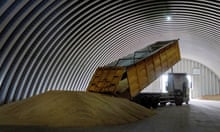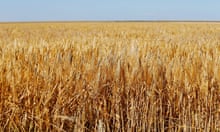Wheat is on the verge of rotting in Ukraine’s warehouses. Piles of it have been stuck in storage since Russia invaded in February and imposed a blockade on Ukrainian ports in the Black Sea, from where the bulk of wheat is exported. This immediately disrupted global wheat exports from the two countries, which together provide 30% of world supply, and completely cut off Ukraine’s 9% share.
The blockade sparked global panic about where to buy wheat, particularly in countries in north Africa and the Middle East which rely on grain imports from the region and already face food shortages on top of economic and climate crises. Global wheat prices soared.
Ukraine lags behind China, the US, Canada and India in its wheat production but most of the harvests from these countries are consumed locally. With large wheat reserves, India initially appeared best placed as an alternative global supplier after the invasion, but the government said it is prioritising its own population after an intense heatwave damaged some of this year’s harvests.
International efforts are under way to open up Ukraine’s ports, which would free up about 22m tonnes of stored grain for export, and create much needed space for this summer’s harvest.
However, there are concerns about how much wheat Ukraine can produce in the future. The war has disrupted the planting season, and harvests this year could be a third lower than in 2021. Labour shortages, ongoing fighting and the need to search half the country for mines means that even wheat planted might not be harvested.
Until the Russian invasion, the Black Sea region had been increasing exports, competing with the giant global food suppliers of North America and western Europe. Russia and Ukraine accounted for almost 30% of the world’s traded wheat, 75% of sunflower oil and 20% of maize, mostly as feed for livestock. Other countries grow far more – China’s wheat crop is the largest in the world, and 80% higher than Russia’s – but keep most for their own populations.
The blockade means Ukraine’s giant wheat silos are still full from the last harvest. The country needs exports to restart so it can store the next harvest. Russia’s own ports have been affected by shipping insurers designating most of the northern Black Sea and Sea of Azov as high-risk areas. Trade now comes with risk to ships and crews along with high insurance premiums, increasing the cost of their cargo. Ukraine has begun moving some exports by rail through neighbouring countries, but this amounts to just 15% of what it had shipped by sea.
The route out of the Black Sea, through the Bosphorus strait and out to the Mediterranean had been so convenient that wheat from Ukraine and Russia dominated exports to the Middle East and north Africa, where bread is a cheap and crucial staple. Grain shipments from anywhere else would take much longer and cost far more. And, as happened in India, alternative suppliers may find their own harvests affected by the climate crisis.
Some countries in north Africa and the Middle East received, on average, more than 30% of their wheat imports from Russia and Ukraine between 2016 and 2021. Over five years, Egypt sourced 82%, Lebanon 81% and Turkey 79% from the two countries.
So far, wheat shortages have been avoided. After an initial slowdown, Russian exports resumed, reaching just over 3m tonnes in April, with just under half going to Turkey and Iran and a similar amount to undeclared destinations. The most dependent countries, like Egypt, which is the world’s largest wheat importer, urgently sought alternative sources from their own farmers and abroad, but these are pricier and can involve trickier shipping logistics. Egypt’s first tender for wheat since the war started, bought from France, Russia and Bulgaria, cost about 50% more than before the war. The country needs a long-term solution unless Ukraine’s ports are opened.
Before the Russian invasion, countries in north Africa and the Middle East were already facing serious difficulties. Civil war had disrupted food supplies in Syria and Yemen, and the UN has repeatedly warned of famine in Yemen. It had been receiving about 30% of its wheat from Ukraine, but this has now stopped, adding to Yemen’s precarious situation. Aid agencies have warned that rising costs of staple commodities and cuts in aid budgets could mean they have less food for refugees and those displaced by fighting. UN appeals for Syria and Yemen are underfunded.
There is also serious concern for Lebanon, which is in financial crisis. Last year, the inflation rate was the highest in the world, and staple foods increased by 351%. Tunisia, which imports about half its wheat from Ukraine, was, along with Egypt, already experiencing rising food prices. There are fears that the cost of bread, which is subsidised by the government in both countries, will increase. Tunisia also has a fragile economy, high unemployment and large debts.
Compounding the disruption to wheat exports are rising fuel and energy prices and the impact of Covid. Prices in the World Food Programme’s food basket – the cost of a staple diet in a particular country or region – increased throughout the Middle East and north Africa, where the organisation works (these are countries with a history of food security problems) between December 2021 and March 2022. Before the invasion, the WFP had already cut the number of people it can feed in Yemen from 13 million to 8 million, and has warned of extra cuts unless it receives more funding.
The shipping routes that serve the Middle East also extend beyond the Red Sea and down the eastern coast of Africa. Sudan relies most directly on Russia and Ukraine, where it sources 58% of its wheat imports. According to the UN, wheat prices in the country are now 180% higher compared with last year, and about 30% of people will need aid. The UN has warned that shipping disruption will worsen food security in Ethiopia, Kenya and Somalia. Somalia received more than half its wheat from Ukraine in 2020. Though other grains are widely consumed, wheat makes up a third of consumed cereals in eastern Africa, but 84% of it is imported, according to the UN.
East Africa and the Horn of Africa were facing serious food insecurity before the invasion. Repeated failed rains threaten the worst drought in 40 years, which is already causing mass displacement and threatening famine as crops fail and livestock dies. The war in Ukraine means higher prices for consumers globally, but also higher prices for humanitarian agencies helping people experiencing drought in eastern Africa. Costlier imports also puts more strain on the budgets of governments in the region, where public debt rose an estimated 11% during the pandemic. This prompted Macky Sall, Senegal’s president and chairperson of the African Union, to visit Russia on 3 June and ask Vladimir Putin to release Ukrainian exports. He told the Russian president that countries far from the war are suffering as a result.
The WFP says food security in the region is growing increasingly precarious. It now views nine countries as at moderate or high risk of serious hunger. It has particular concerns for Somalia, where this year more than 500,000 people have been displaced by drought. South Sudan has also been caught in a cycle of natural disasters and violence that has disrupted farmers and herders and partially cut off aid to the most vulnerable. Drought, poverty and a large refugee population are taking a toll on food security in Uganda.
Data and source notes
Average wheat production by region
The United States Department of Agriculture. 2016-2020; five-year wheat production average, thousand metric tonnes.
Russian controlled areas
Rochan Consulting, the Institute for the Study of War with the American Enterprise Institute’s (AEI) Critical Threats Project. Accurate as of 7 June 2022.
Black Sea activity and shipping routes to the Middle East and north Africa (Mena) and East Africa
All data was provided by Maritime intelligence firm MariTrace. Bulk carrier data shows activity on i) 23 February and ii) 4 April 2022.
‘Major shipping routes’ is indicative of commonly travelled journeys from the ports of Odesa in Ukraine and Novorossiya in Russia to a single major port per country in the Middle East, north Africa and east Africa.
“High-risk” areas correspond to Joint War Committee zones.
Net wheat importers
Share of wheat imports from Russia and Ukraine provided by the International Grains Council (IGC). Net importers in north Africa and the Middle East with average annual all-wheat purchases (wheat, durum and wheat flour (grain equivalent)) of more than 0.5m tonnes over the period from 2016/17-2020/21 (July/June) and a combined (Russia and Ukraine) import share of more than 30%.
WFP food basket price change, for the Mena region
World Food Programme. Percentage price rise between December 2021 and March 2022 has been calculated from the figures showing cost in local currency unit/per person/per month.
Food insecurity, east Africa
Prevalence of moderate to severe food insecurity in the total population in east Africa, SOFI report, 2021, UN Food and Agriculture Organization. Additional source: Dr Monika Tothova, FAO economist.
Current food security outlook
Countries designated by the World Food Programme’s Hunger Map, as of 7 June, 2022.








